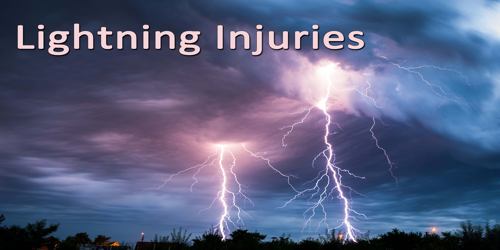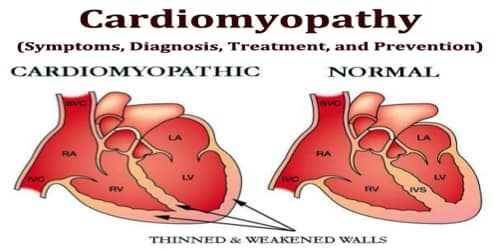Lightning Injuries
Definition
Lightning injuries are a major source of injury and death from the environment, lightning is one of the top three causes of death from environmental origins. They result from three factors:
- electrical damage.
- intense heat.
- the mechanical energy which these generate.

Far more injuries and deaths occur in tropical and subtropical developing countries, and newspaper reports frequently list multiple injuries and deaths in each event. Most people killed or injured by lightning are outside doing recreational activities such as fishing, boating, swimming, or playing sports. Others are working outdoors at construction jobs. Farmers are often struck, too.
Causes and Health Effects of Lightning Injuries
Lightning is neither a direct current nor an alternating current. It is a unidirectional, massive, current impulse with several return strokes back to the cloud. Once the connection from the cloud is made, a tremendously large current impulsively flows for an incredibly short time. The most important difference between lightning and high-voltage electrical injuries is the duration of exposure to the current. Lightning has only brief contact with the skin. There is not enough time to allow skin burns. Internal burns and renal failure play a small part in the injury pattern from lightning. Respiratory and cardiac arrest, vascular spasm, and neurologic damage are potentially serious consequences of lightning injuries.

Injury from a lightning strike may occur in any of these ways:
- Direct strike: Lightning directly strikes a person.
- Contact strike: A person is touching an object (such as a tree or pole) that has been struck by lightning.
- Side splash: Lightning jumps from the primary strike object on its way to the ground.
- Ground strike: Lightning strikes the ground and the current spreads out in a circle from that spot.
- Blunt injury: A person is thrown violently from the lightning strike or from the explosive force that occurs as surrounding air is superheated and rapidly cooled.
- Upward streamer: When a low-energy electrical charge streams upward to meet a downward leader, it may carry enough current to cause electrical injury even if it does not connect with the downward current to complete the lightning strike.
People in many countries believe in two kinds of lightning: “natural lightning” and “man-made lightning” that can be called down by witches or can be prevented with charms, herbs, or burying something under a structure as it is being built. In Zambia, it is believed that wearing the color red attracts lightning. Others believe that anyone injured by lightning has been cursed, shunning them and their family. Families may believe their only recourse is to move and start over in a village where their history is unknown.

Lightning may cause numerous other injuries:
- Heart damage or cardiac arrest may occur.
- Up to two-thirds of the seriously injured people struck by lightning have keraunoparalysis – a temporary paralysis unique to a lightning strike.
- Victims may experience superficial burns. Contrary to common belief, deep burns are rare. They occur in few lightning injuries.
- Various types of broken bones and dislocations may be caused by lightning.
- Skull fractures and cervical spine (neck) injuries may result from associated blunt trauma.
- Lungs may be damaged, causing shortness of breath.
- An eye injury may cause immediate visual problems or delayed cataract formation.
- The eardrum is commonly ruptured. This causes pain, hearing loss, and dizziness.
For most thunderstorms, 70-90% of lightning strikes are intracloud or from cloud to cloud. From 10-30% of lightning can be cloud to ground (CG), depending on the storm. Lightning strikes the earth more than 100 times each second and 8 million times per day. Worldwide, approximately 50,000 thunderstorms occur per day that may result in forest fires, injury to animals and people, and/or damage to electrical and communications lines and electronics, leading to millions of dollars in downtime for businesses. Everyone is a potential victim.
Diagnosis and Treatment of Lightning Injuries
The doctor may order some tests depending on the history of the strike and the findings of the physical examination. Some of the tests that might be ordered include the following:
- ECG (electrocardiogram) to check the heart
- Heart monitor to watch for arrhythmias (rhythm disturbances of the heart)
- CT scan of the brain or abdomen
- X-rays
- Laboratory tests such as blood count and chemistries including enzymes that may indicate heart damage.

Reported mortality rates range from 10-30 percent, depending on the source of data. Most people who are struck by lightning live to tell the story, but many suffer from long term injury or disability. The doctor will treat those injuries that are discovered on the physical examination.
- Head injury indicated by a loss of consciousness and or confusion is frequently treated by observation in the hospital.
- Possible injury to the heart that shows up on an abnormal ECG or in blood enzyme levels is usually managed in the hospital by observation and medicine if needed.
- Ear and eye injuries are treated as needed with referral to an appropriate specialist.
- Keraunoparalysis is usually temporary but may require observation in the hospital.
- Spine injuries usually require hospitalization for observation or surgical stabilization.
- Broken bones may be treated with splinting or may require surgery.
A complete physical examination by paramedics or physicians may reveal ruptured eardrums. Ocular cataracts may later develop, sometimes more than a year after an otherwise uneventful recovery. Long-term injuries are usually neurological in nature, including memory deficit, sleep disturbance, chronic pain, and chronic dizziness.
Reference:
















